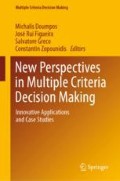Abstract
When the Municipality of Turin first decided to invest in social innovation, a public program and a network of partners were created, and a procedure to support social innovation start-ups was developed, and applied for the first time in 2014. After selection and funding of several young social entrepreneur projects, the Municipality activated a monitoring process. Different methodological approaches, including cognitive mapping, actor network analysis and multicriteria analysis, have been combined to analyse the behaviour of these start-ups and to evaluate whether they would address the social needs of their specific fields, and develop business projects as part of an inclusive and sustainable economy. Each element of this analysis has been proposed and discussed in relation to the monitoring and decision processes. The adopted multi-methodology and its results are here presented as a proposal for new models, metrics and methods for the social economy.
Access this chapter
Tax calculation will be finalised at checkout
Purchases are for personal use only
Notes
- 1.
The name of the project, FaciliTO, combines the word facilitation with TO, the acronym of Turin, while Giovani (Italian word that means the young) identifies the young social entrepreneurs who have been the subjects and targets of the project.
References
Bana e Costa, C. A. (2001). The use of multi-criteria decision analysis to support the search for less conflicting policy options in a multi-actor context: Case study. Journal of Multi-criteria Decision Analysis, 10, 111–125.
European Commission. (2013). Guide to social innovation. EU Commission, Brussels. https://ec.europa.eu/eip/ageing/library/guide-social-innovation_en.
Figueira, J., Mousseau, V., & Roy, B. (2005). ELECTRE methods. In J. Figueira, S. Greco, & M. Ehrgott (Eds.), Multiple criteria decision analysis: State of the art surveys (pp. 133–162). Dordrecht: Springer.
Genard, J.-L., & Pirlot, M. (2002). Multi-criteria decision-aid in a philosophical perspective. In D. Boyssou, E. Jacquet-Lagrèze, P. Perny, R. Slowinski, D. Vanderpooten, & P. H. Vincke (Eds.), Aiding decisions with multiple criteria: Essays in honour of Bernard Roy (pp. 89–117). Dordrecht: Kluwer Academic.
Hermans, L. M., & Thissen, W. A. H. (2009). Actor analysis methods and their use for public policy analysists. European Journal of Operational Research, 196, 808–818.
Law, J. (2007). Actor network theory and material semiotics. Indiana Law Journal, 35, 113–139.
Merad, M., Dechy, N., Serir, L., Grabisch, M., & Marcel, F. (2013). Using a multicriteria decision aid methodology to implement sustainable development principles within an Organization. European Journal of Operational Research, 224(3), 603–613.
Norese, M. F. (2009). A multi-criteria decision aiding system to support monitoring in a public administration. International Journal of Decision Support System Technology, 1(4), 59–71.
Norese, M. F. (2010). How to support decisions and guarantee robustness in Multi Criteria Decision Aid when the preference system is not “accessible”. In C. Zopounidis, M. Doumpos, N. F. Matsatsinis, & E. Grigoroudis (Eds.), Multiple criteria decision aiding (pp. 1–16). New York: Nova Science Publishers.
Norese, M. F., & Torta, V. (2014). A decision support system in order to facilitate new financing actions in the public sector. Territorio Italia, 2, 85–100.
Norese, M. F., & Salassa, F. (2014). Structuring fragmented knowledge: A case study. Knowledge Management Research & Practice, 12(4), 454–463.
Norese, M. F. (2016a). A model-based process to improve robustness in multi criteria decision aiding interventions. Journal of Multi-Criteria Decision Analysis, 23(5–6), 183–196.
Norese, M. F. (2016b). Decision aid in public administration: From evidence-based decision making to organizational learning. In C. Zopounidis & M. Doumpos (Eds.), Multiple criteria decision making: Applications in management and engineering (pp. 1–29). Heidelberg: Springer.
Norese, M. F., Mustafa, A., & Scarelli A. (2016). New frontiers for MCDA: From several indicators to structured models and decision aid processes. Newsletter of the European Working Group “Multiple Criteria Decision Aiding”, 3(34), Fall 2016, 1–8.
Rosenhead, J., & Mingers, J. (Eds.). (2001). Rational analysis for a problematic world revisited: Problem structuring methods for complexity, uncertainty and conflict. Chichester: Wiley.
Roy, B. (1990). The outranking approach and the foundations of ELECTRE methods, In: C. A. Bana e Costa (Ed.), Readings in multiple criteria decision aid (pp. 155–184). Heidelberg: Springer.
Roy, B. (1996). Multicriteria methodology for decision aiding. Dordrecht: Kluwer.
Roy, B., & Bertier, P. (1973). La methode ELECTRE II—une application au media-planning. In M. Ross (Ed.), OR’72 (pp. 291–302). Amsterdam: North-Holland.
Roy, B., & Bouyssou, D. (1993). Aide multicritère à la décision: mèthodes et cas. Collection Gestion, Paris: Economica.
Tsoukias, A., Montibeller, G., Lucertini, G., & Belton, V. (2013). Policy analytics: An agenda for research and practice. EURO Journal Decision Processes, 1, 115–134.
Yu, W. (1992). ELECTRE TRI: Aspects mèthodologiques et manuel d’utilization. Document du LAMSADE n°74 LAMSADE Université Paris-Dauphine.
Author information
Authors and Affiliations
Corresponding author
Editor information
Editors and Affiliations
Rights and permissions
Copyright information
© 2019 Springer Nature Switzerland AG
About this chapter
Cite this chapter
Norese, M.F., Barbiero, F., Corazza, L., Sacco, L. (2019). The Monitoring of Social Innovation Projects: An Integrated Approach. In: Doumpos, M., Figueira, J., Greco, S., Zopounidis, C. (eds) New Perspectives in Multiple Criteria Decision Making. Multiple Criteria Decision Making. Springer, Cham. https://doi.org/10.1007/978-3-030-11482-4_13
Download citation
DOI: https://doi.org/10.1007/978-3-030-11482-4_13
Published:
Publisher Name: Springer, Cham
Print ISBN: 978-3-030-11481-7
Online ISBN: 978-3-030-11482-4
eBook Packages: Business and ManagementBusiness and Management (R0)

